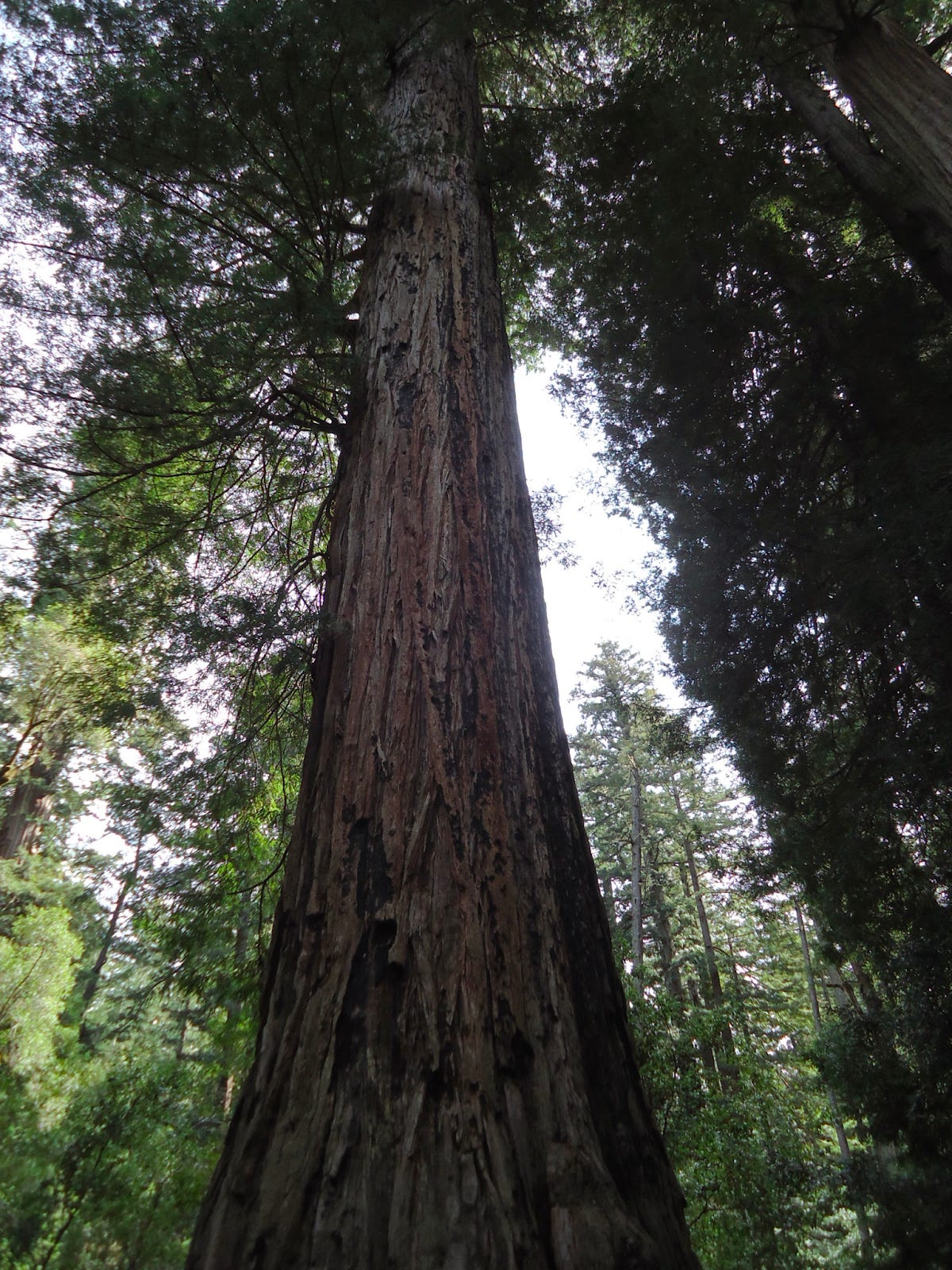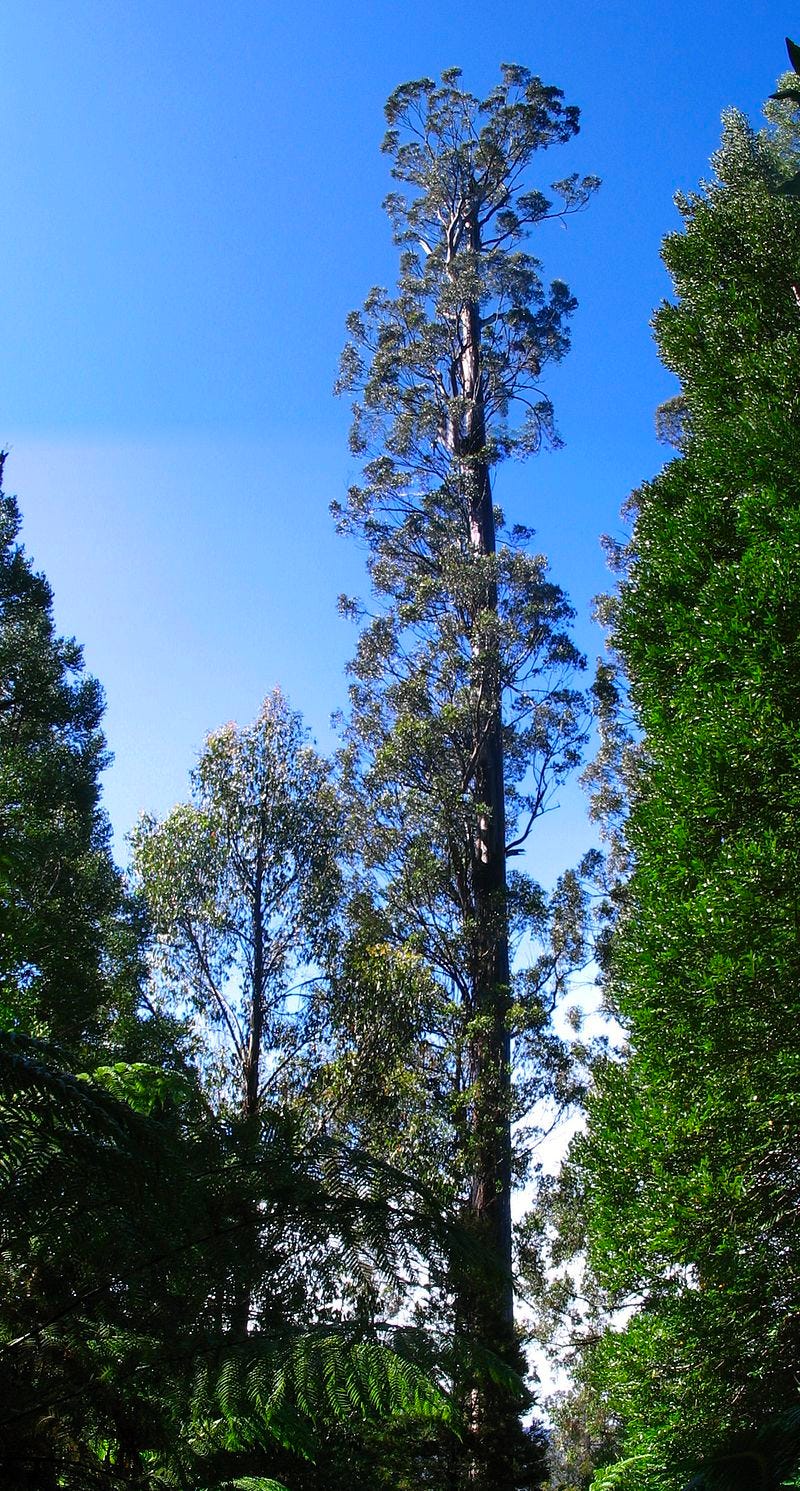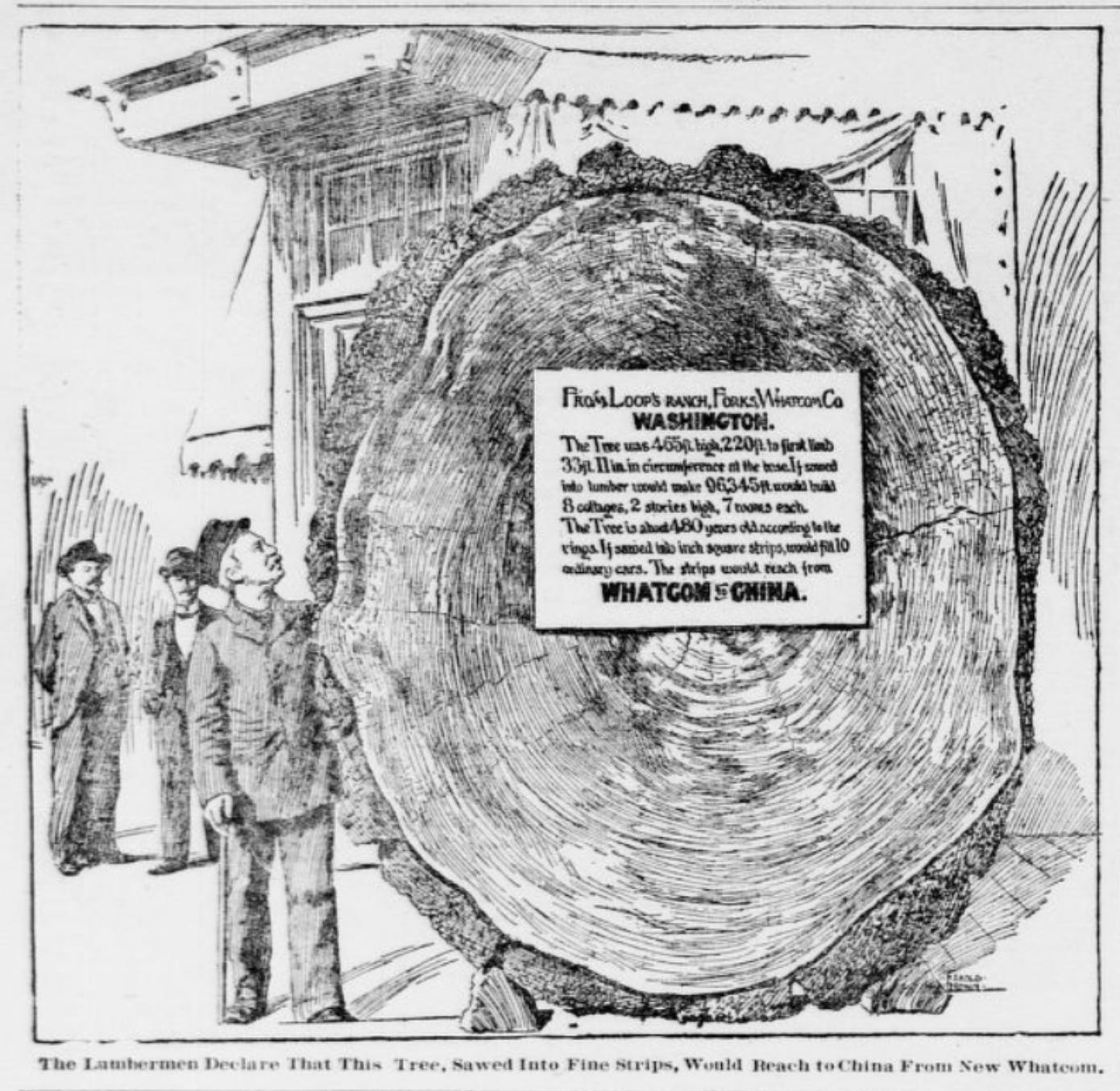Mark Slavonia (MJS) is an investor, a pilot, and an avid cyclist. He wrote about radio altimeters, rowing machines, traveler’s checks, and more. He posts other things that are interesting on his website.
A coast redwood. Not the tallest one.
Mark here. The tallest known living tree, a California coast redwood named Hyperion, was discovered in 2006 and stands 381 feet (116 meters) tall. The tallest trees in the world are California coast redwoods (Sequoia sempervirens). Their close cousins, the giant sequoias, are the most massive.
But it might not have always been this way.
Why is this interesting?
On February 21,1872, William Ferguson, Inspector of State Forests for Victoria, Australia, made a report to his boss, the Assistant Commissioner of Lands and Survey. Fortunately it was a slow news day in nearby Melbourne, and the Melbourne Sun ran the report on page 3 the next day. While surveying the nearby forests, Ferguson wrote, he discovered a downed tree that he measured to be 435 feet (133 meters) long. The treetop was broken off and missing, leading Ferguson to guess that the tree might have exceeded 500 feet when living.
The Ferguson Tree wasn’t a redwood, a sequoia, or a pine. It wasn’t even a conifer tree. It was a type of eucalyptus called a mountain ash (Eucalyptus regnans). Existing mountain ash trees are giants, too. The largest known mountain ash, the Centurion tree in Tasmania, is over 330 feet tall (100 meters) and is still growing.
The Centurion Tree, the tallest known mountain ash
The old growth forests of redwoods and mountain ashes were both extensively logged in the late 19th and 20th centuries, leaving only a small remnant of the world’s largest tree species alive. The Save the Redwoods League estimates that less than 5% of the original old growth redwood forest remains today, and the pattern is similar for mountain ash in Australia and Tasmania. We are, essentially, comparing lions to tigers by measuring animals in the zoo.
Eucalyptus trees aren’t even in the same Clade (broad grouping) of plants as redwoods. Eucalyptus trees are angiosperms (flowering), redwoods are gymnosperms (non-flowering). Mountain ash trees are more closely related to dandelions and rice than they are to redwoods.The emergence of plants with tall stalks covered with photosynthesizing green canopies has occurred independently several times in nature in a striking example of convergent evolution. What we think of as a “tree” is really a strategy, not a biological classification. It is a fascinating coincidence that the tallest flowering trees (mountain ash) and the tallest non-flowering trees, only very distantly related, top out at such similar heights.
Before we give up on redwoods, it’s worth considering that perhaps the tallest redwoods in history overtopped the Ferguson Tree and can rightly be considered king of the forest. Were there redwoods taller than Hyperion? Of course - the species dates back to the dinosaurs. Even in human history there have been larger redwoods measured. The Chicago World’s Fair of 1893 featured a section of a coast redwood that was claimed to be 427 feet (130 meters) tall when felled on Valentine’s Day, 1893.
Once one starts to wander into the dark forest of cryptobotany, the tales, and the trees, get taller still. At this point in our story the Douglas fir makes a dramatic entrance. Douglas fir is a very common tree used for dimensional lumber and Christmas trees, but they can grow to extraordinary heights. The tallest living Douglas fir is about as tall as the tallest living mountain ash (330 feet/100 meters), and pre-1900 stories of 400 foot firs pepper the Northwest U.S. and British Columbia. In 1897 a Douglas fir known as the Nooksack Giant was felled for timber in Whatcom, Washington. The local paper claimed that it had stood 465 feet (142 meters) tall. The March 7, 1897 edition of the New York Times decried that the cutting down of such a giant was “a truly pitiable tale”.
The Nooksack Giant, from The Washington Morning Times, Feb. 28, 1897
I doubt that anyone could sort these stories and fables for credibility and determine which of these trees deserves pride of place, but it is a fascinating reminder that the old growth forests that remain today are a small fraction of the forests that once grew on Earth, and that much of what we know about the natural world is seen only through the filter of time, after the impact of generations of humanity.
An excellent jumping-off point for learning about outstanding and unique trees is the Wikipedia page for Superlative Trees, Prepare to dive deep.
—
Thanks for reading,
Noah (NRB) & Colin (CJN) & Mark (MJS)
—
Why is this interesting? is a daily email from Noah Brier & Colin Nagy (and friends!) about interesting things. If you’ve enjoyed this edition, please consider forwarding it to a friend. If you’re reading it for the first time, consider subscribing.







Great article, it makes one truly wonder which was the tallest of them all! With the addition of the Tibetan Cypress to the list of 100 meter+ giants, as well as the flowering Yellow Meranti, it seems that our understanding of tall trees has expanded significantly in the past few years! I think between Eucalyptus, Redwood and Douglas fir it may well be a toss up, for tallest of the past, and perhaps they are all physically limited to somewhere between 400-450 or <500 ~ ft, (120-150 m) as an upper theoretical maximum. In 2006 I began reading the works of the late Expert Dr Al Carder, and from then on started compiling historical accounts of Douglas fir exceeding 300 and 400 feet. Since that time, I have collected over 300 entries. The Nooksack tree is the tallest I had found in this quest, in Feb. 2009 in old Google books archives, and then worked with Ron Judd of the Seattle Times in his 2011 article which sort of resurrected this long forgotten behemoth. That particular tree graces the upper bounds of physics and the imagination, and there is no modern way to test this and other historic fallen giants. Exaggerations and over-estimations of standing tree heights were known in the days before laser range finders, but fallen trees which could be measured prone and bucked into marketable lengths would tend to be more accurate I contend. That particular tree was cut down by Alfred Bruce Loop in 1896 while he was improving his 150 acre claim, and sections displayed in the town of New Whatcom that and the following year or so. It was reported to be a lean 11 feet diameter or 34 ft girth, (this may have been exclusive of bark) and 220 feet to the first limb, and 96,345 board feet. While its exact height is impossible to verify, it does strike me as impressive that nearly 100,000 board ft merchantable was yielded from it, and this likely being number 1 grade in those 220 feet of branchless stock. Similar 11 foot diameter firs in the 300-350 ft range generally would yield about 50,000 bf, based on an analysis I had conducted in 2013. So this suggests to me, it was very tall, possessing twice the usual vol. for an 11 ft diameter fir. Around 2015 I had found a further interesting newspaper account of a survey in the west fork of Nooksack river in 1891, about 15 miles west of Loop's ranch - by John Saar and Sidney Soule, who were inspecting timber for the World's Fair near the town of Nooksack, and Everson. They described a stand of Fir timber that they judged was 350 to 400 feet in height, one tree they said was a lean & perfect specimen not over 9 ft in diameter, possibly 400 feet in height and at least 200 ft to the first branch - a single acre of this grove they cruised at half a million board feet for the fir alone, not counting Cedar. So there seems to be some extra anecdotal support for potentially some fir trees reaching 400 feet along Nooksack river valley, over 120 years ago. The best data we have on a reliably recorded "four hundred" footer, is probably the Mineral tree, from Washington state. Dr Al Carder and Dr Robert Van Pelt investigated this one for their 1995 and 2001 books, and concluded it was about 393 ft tall, based on several foresters and land engineers who had independently measured the fallen top, and standing snag between 1905 ad 1930. This tree I believe sets sort of the benchmark for what was possible in Pseudotsuga. Later on, in 2020, I subsequently found a news report of a fallen 405 foot long fir tree in the Nehalem river valley, in the year 1886 on a man named Wick's property. The monolithic tree was said to still be 14 ft diameter 100 feet up. This valley also had settler's accounts and timber cruises of fir trees 350 and 360 feet high in that period. I also found some very tall Redwood accounts around this time - Probably the best documented giant 400 foot class Redwood I had found was the above mentioned Eel river tree. In late December 2019, I found it in online archives and many subsequent photographs, and the Niagara museum photos. This tree is compelling in several ways, as the man who was charged with bucking it into sections, Mr. John Henry French (father of Enoch "Percy" French), was quoted by the Del Rio correspondent of the Eureka Times newspaper, that he believed the giant tree stood 417 feet tall orginally, and was still 9 feet thick 220 feet up, where it fractured in the falling. Another paper reported that the giant tree was 427 feet long as it laid, and was still 9 feet thick, 274 feet from the stump, and it was over 24 feet in diameter - the dwonfall of the monarch was said to have been heard ten miles, and two twelve foot saws had to be brazed together to cut it, which took several days to do! There were also several instances of Redwoods 400 feet tall or long, reported at Elk river, Klamath, and at Russian River in Sonoma county in early days reports. The Crannell creek giant, Lindsey Creek tree, as well as the Eureka tree, may well too have been 300-390 foot giants which possessed more volume than General Sherman Sequoia! I.E. perhaps more than 50,000 cubic ft. All that aside, I believe Ferguson's tree at the Watts river in 1872 is quite possibly the tallest tree ever well documented, as he was a forestry official and recorded his method of measurement with the tape line - and that it was still 3 ft diameter 435 feet up, suggests indeed a nearly 500 foot tree. He furthermore documented other fallen 350 foot trees in his survey at the Watts river, which suggests the forest contained many other giants. It will be truly interesting in the next few decades to watch which tree species becomes the tallest, as second growth 100 year old Eucalyptus Regs are already 300 feet tall or so, and Douglas fir has now been documented to reach 301 ft in about 120 years on living specimen.
You may find it interesting to know that in the Yarra Ranges, Victoria, Australia, where the hills are covered in magnificent mountain ash there is a stand of equally magnificent redwoods which were planted as part of a hydrology experiment conducted by the Board of Works in the 1930s. They are a popular tourist destination although they are currently off limits due to a bridge collapse on the access road. For more information see https://trusttrees.org.au/tree/VIC/Warburton/Cement_Creek_Road